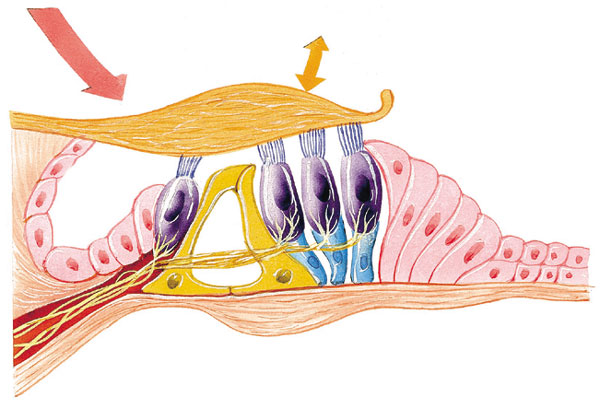PSYC 170 - Summer 2013 - Professor Claffey
Notes: Other Senses
PDFHearing
Sound
a wave of air pressureamplitude of the wave - ______________
frequency of the wave - ______________ (with some caveats)
complexity (how many frequencies) - ______________
natural sounds are made up of many different frequencies
Ear
tonotopic organization - by ________________
Auditory pathways
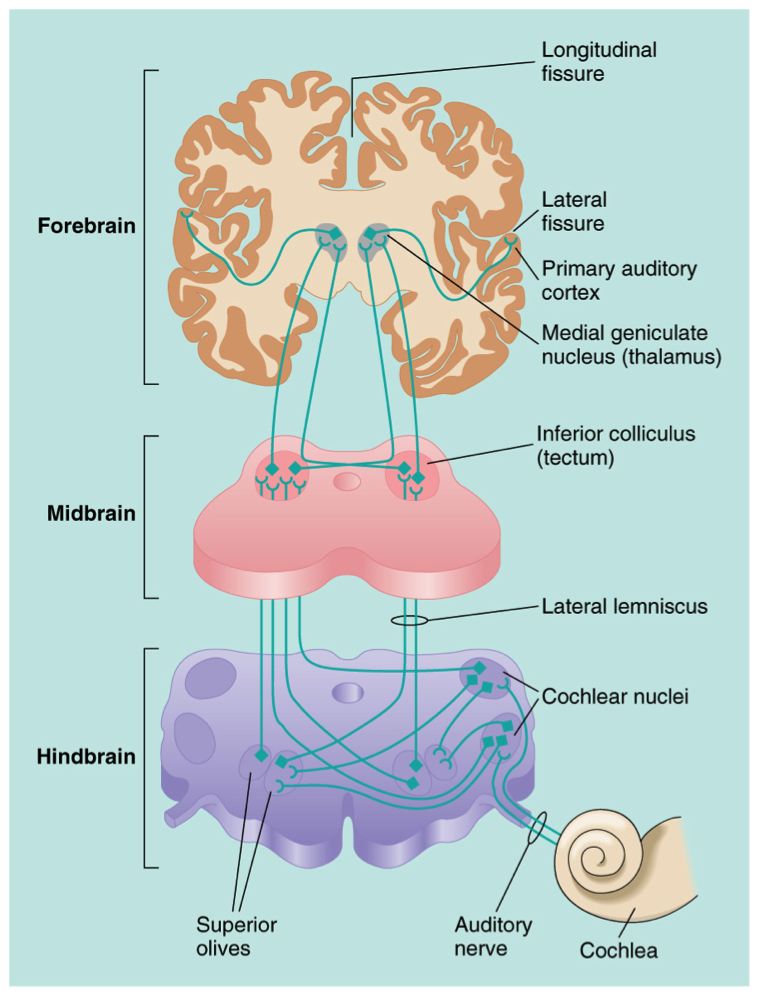 |
 cochlea -> auditory nerve -> hindbrain -> cochlear nuclear - input from only one ear (From here on input from one/both ears) superior olives - sound localization thalamus medial geniculate nucleus primary auditory cortex |
Auditory Cortex
primary auditory cortex - inside (medial) temporal lobefunctional columns organized by frequency
stimulation leads to perception of ____________________________
secondary auditory cortex - outside (lateral) temporal lobe
stimulation leads to perception of ____________________________
pathways leaving the auditory cortex
anterior auditory pathway - towards prefrontal cortex - ________ a sound is
posterior auditory pathway - towards parietal lobe - __________ a sound is
posterior parietal cortex
neurons in monkeys that respond to both vision and sound
integrating vision and hearing
Audition is not as extensively mapped out as vision
Damage
Lesions to auditory cortex = only temporary deafnessLong term problems with sound localization and pitch differentiation
damage to cochlea or auditory nerve = ______________ deafness
loss of hair receptors
characteristic of age-related hearing loss
perception of ringing ("ringing in the ears") = ______________
cutting auditory nerve from ringing ear doesn't eliminate ringing
may originate in the central nervous system
Somatosensory system
somatosensory - sensations of the bodystereognosis - identifying objects by touch
Cutaneous Receptors
principle
fast versus slow adaptation
fast are necessary for quick responses but,
without adaptation, would be overwhelmed by continuous stimuli
slow are necessary for background information
about continuous stimuli
MechanoreceptorsPerceive pressure, vibration (texture), stretchThermoreceptorsdetect changes in ______________typically free nerve endings (not specialized structures) different receptors for detecting heat and coolness Nociceptorsnoci = ______________detect stimuli that could be damaging to tissue receptors for: extreme temperature, skin deformation, skin incision, chemicals (capsaicin) fast & slow conducting channels - immediate and chronic pain |
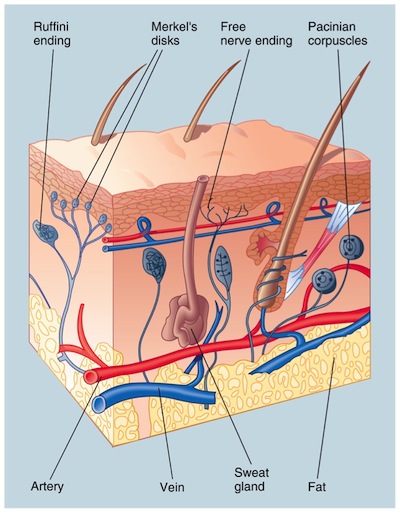 |
Somatosensory Pathways
dermatomesnerves from cutaneous receptors enter the dorsal route of the spinal cord
areas of the body that carry information to the same segment of the spinal cord are called dermatomes
1. dorsal-column medial-lemniscus system
information about ____________________
spinal cord -> ventral posterior nucleus (thalamus) ->
primary/secondary somatosensory cortex or posterior parietal cortex
3 neurons from toe to cortex
2. anterolateral system
information about ____________________
3 different tracts to different areas of the brain
lesions of spinothalamic tract reduce sensitivity to __________
lesions of spinoreticular tract relieves ______________
Somatosensory Cortex
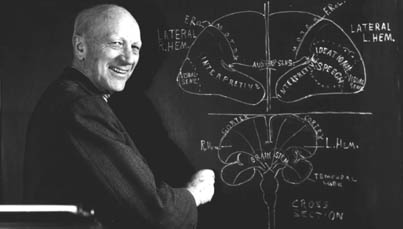 Source: http://www.mcgill.ca/about/history/more-history/firsts/1950 |
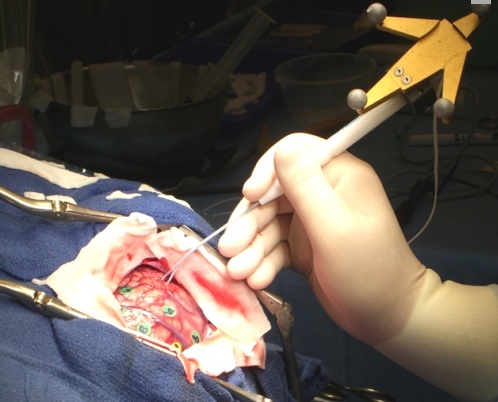 Source: http://www.isis-robotics.com/en/references.html |
1937 - Dr. Wilder Penfield electrically stimulates the cortex of patients
finds an area that produces sensations through out the body
somatosensory cortex
______________ organization
areas of the body that are close together are represented close together in the brain
like retinotopic and tonotopic
somatosensory _______________
a "little man", or representation of the body in the somatosensory cortex
larger areas of cortex dedicated to areas of the body with greater sensitivity
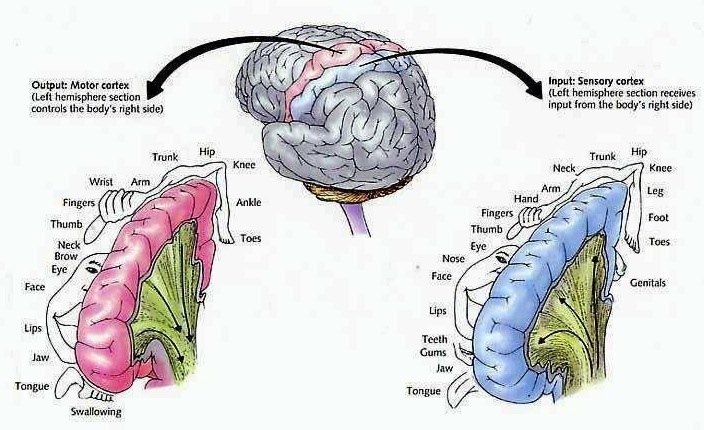 Source: http://brainmind.com/BrainLecture8.html |
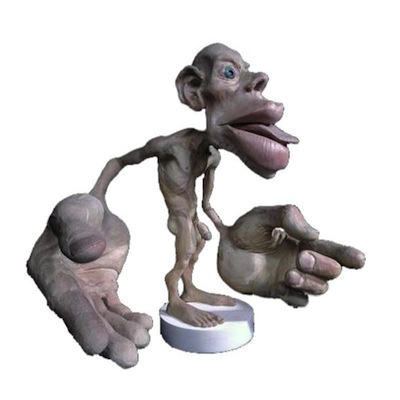 Source: http://daphne.palomar.edu/ rmorrissette/physio/studentwebpages/ 2006spring/phantom%20pain/ web%20page.htm |
contralateral input to primary somatosensory cortex
the _______ side of the brain receives input from only the _____ side of the body (and vice versa)
secondary somatosensory cortex
just ventral to primary somatosensory cortex
receives input from both sides of the body
receptive fields
excited by stimulus to a given area on the body
inhibited by stimulus to the surrounding areas
cortical organization
columns (moving down from the surface) - all neurons tend to respond to same area of body
strips (moving across the surface) - different stimulus types: touch, temperature, pain
posterior parietal cortex
receives information from both primary and secondary cortex
we already learned: also receives input from visual and auditory cortex
contains __________ neurons that response to two senses, like vision/touch
for a given neuron, the visual field "moves" to stay with corresponding part of the body
case study: W.M. - using your hand to improve visual attention
this area of the brain __________ information for different senses
Chemical sense
the "oldest sense"even single cell bacteria can sense chemicals in their environment
____________ - smell, detecting chemicals in the air
_________ - taste, detecting chemicals in the oral cavity
___________ - the combination of smell and taste
____________ - chemical signals to other members of the species
Olfactory System
 |
chemicals are detected by
receptors on the membrane of dendrites in the nose humans have _________ distinct receptor proteins neurons typically have a single receptor type odors activate multiple receptors olfactory pathway receptors -> olfactory bulb -> inputs are grouped by similar receptor type piriform cortex / amygdala -> ~primary olfactory cortex retinotopic, tonotopic, somatotopic -> smellotopic? no known principle for how odors are organized across olfactory bulbs (no such thing as "smellotopic") ______________ - the birth of new neurons olfactory receptors are replaced every few weeks grow axons to the correct place in olfactory bulb one of the few brain areas with noticeable neurogenesis |
Gustatory System
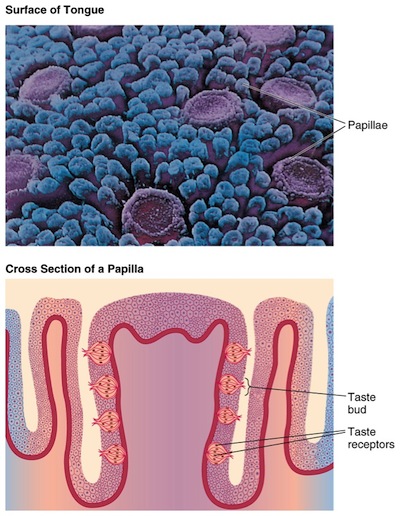 |
___________ - clusters of
approximately 50 taste receptors taste receptors do not have axons many taste receptors pool to an output neuron 33 receptor proteins identified conventional tastes 1. sweet - ______________, 2 known receptors 2. sour - _____________, influence ion channels directly 3. bitter - 30 known receptors 4. salty - __________, influence ion channels directly 5. unami - ____________, 1 known receptor pathway leave tongue along 4 different nerves -> (thalamus) ventral posterior nucleus -> primary gustatory cortex (near somatosensory cortex) & secondary gustatory cortex (inside lateral fissure) |
Copyright 2012-2013 - Michael Claffey

